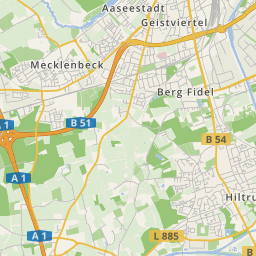











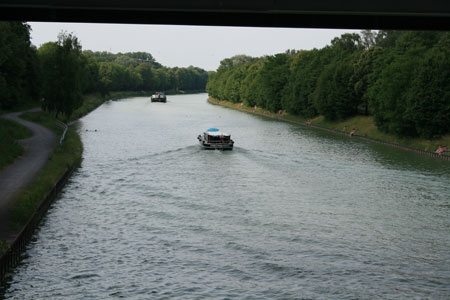
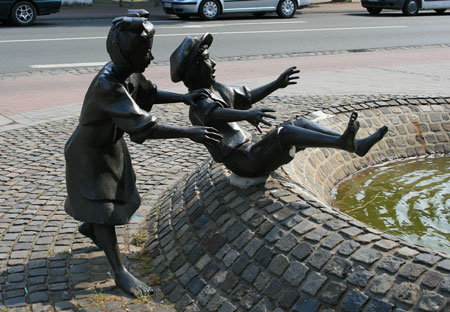
First settlement trails can be traced back in Hiltrup to the time around Christ's birth. At this time, the Germanic tribe Brukterer lived in the Münsterland and also in Hiltrup. Pole traces and a found hearth on the canal island of the Dortmund-Ems-Canal in the south of the district document this. Around 400 years later, when the Saxon had spread also in the Münsterland, Hiltrup consisted of the farming communities Sonneborn, Wentrup and Geest. The Hohe Ward was at that time, a communal used woodland. Around the year 800, when Liudger christianised the formerly Saxon areas in the Münsterland, on order by Charlemagne, around 120 citizens of the three farming communities constructed the first church on the land of the farmer Schulze-Hiltrup. In the year 1160, the construction of the Romanesque church St. Clemens along the present Westfalen Road followed. In the year 1233 the name Hiltrup is first mentioned. Hiltrup's first school opened in the year 1733, a girls' school followed in 1890. Connection to the railway happened in Hiltrup in the year 1848, when the Münster-Hammer Eisenbahn-Gesellschaft finished the construction of the railway line Münster–Hamm. The opening was celebrated at the railway station 'Diecke Wief' (Big Woman), named after the nearby inn 'Dicke Wieve', on the 26th of May. On the 1st of August 1868 the railway station was relocated and the new station Hiltrup opened.
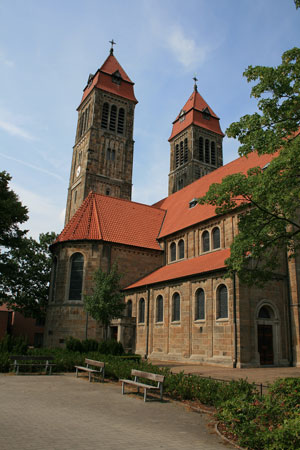
The first fire brigade received Hiltrup in 1892, with the founding of the volunteer fire department Hiltrup. In the year 1894, Pater Hubert Lickens of the Heiligsten Herzen Jesu, founded a missionary monastery at the Roten Berg, which was inaugurated on the 8th of December 1897. A corresponding women's order was founded on the 25th of March 1900; the 'Missionary Sisters of the Heiligsten Herzen Jesu von Hiltrup' founded the Herz-Jesu-Hospital in the year 1964. On the 11th of August 1899 Hiltrup received, with the opening of the Dortmund-Ems-Canal, another traffic connection. Four years later, Max Winkelmann constructed a branch of Glasurit in Hiltrup, which became later the headquarter and after the sale of BASF in the year 1965, as well as the renaming in BASF Coatings, one of the world's most important varnish manufacturers. More important buildings, before the start of the First World War, are the building of the waterworks in Hohen Ward in the year 1907 and the in 1913 consecrated large Clemens church on the present Marktallee. Due to the extending of the railway and the needed sand to bank up the railroad embankments, the Steiner Lake, named after its first leaseholder, was created. Today the lake is known as the Hiltrup Lake and used as a local recreation area.
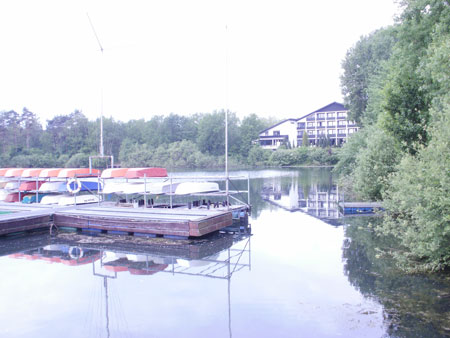
The first important company founding happened after the First World War, with the founding of the Hiltrup calcareous sand works by Leo Schencking in the year 1928. The, two years earlier founded Landwirtschaftsverlag Münster, would move into his villa in the year 1948. Another important building was the construction of the fire Protestant church on the Hohen Geest in the year 1932. After the end of the 2nd World War, in July 1945, the Police Leadership Academy opened, in parts housed in a Gestapo accommodation, which was constructed in the mid-1930ties. Since the 1st of March 2006, the status has changed and it is now named German Police College. In 1956, the Catholic church St. Marien was inaugurated. Nine years later, in the year 1965, Hiltrup was awarded its official coat-of-arms: It depicts a red anchor and a red sum wheel on yellow background. In the year 1970, the second Protestant church in Hiltrup was consecrated, the Christus church on the Hülsebrockstraße. Two years later, the consecration of the 'Waldfriedhofs Hohe Ward' (graveyard). The 1970ties had a special importance for Hiltrup in political respects: Firstly, in the year 1974, started the town twinning with Beaugency in France, secondly, on the 1st of January 1975, Hiltrup lost its independence in the course of the regional reorganisation in North-Rhine Westphalia and was incorporated into the town of Münster.
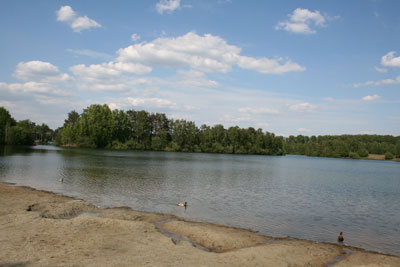
In the year 1980, the Hiltrup municipal hall was completed. It is, apart from the Halle Münsterland, a venue for the bigger events in Münster. Four years later, on the 1st of September 1984 followed the opening of the Hiltrup Museum in the old steam mill. With the extension of the Dortmund-Ems-Canal, at the turn of the century, the canal bridges had to be newly constructed. Against this background, in the year 2001, the world's biggest - at that time - pontoon railway bridge for the railway line Münster–Hamm was floated in. In the year 2002, the Rockwool-Works one of Hiltrup's most important employers, closed. The last shift ended on the 12th of June 2002. In 2003 followed the opening of the Bait ul-Mo’min, Münster's first mosque. Since the 1st of March 2006, Hiltrup has its first own college, the German Police College. It originated from the former police leadership academy, on the order of the Westphalian Landtag.